

Webmaster: Stansfeld, LLC. |
|
|

FEBRUARY 2007 MEETING
Wednesday, February 14, 2007
TECHNICAL PROGRAM
Proper use of Lime to Stabilize Expansive Clay
Speaker: Larry Peirce of Lime Association of Texas, Austin TX., Tel. 512-633-1130.
PRESENTATION SUMMARY
 To a room of about 50, Larry Peirce, Executive Director of the Lime Association of Texas, with over 20 years experience in pavement evaluation and research gave a slide presentation entitled, "Lime Use for Soil Stabilization". He defined "Soil Improvement" as a temporary (about 5 years) soil treatment made by adding lime or another binder, and "Soil Stabilization", as a permanent chemical change designed by engineers to reduce pavement thickness. Contractors may find it cost effective to make their own select fill using onsite cut materials rather than hauling away expansive clay and hauling in select fill.
To a room of about 50, Larry Peirce, Executive Director of the Lime Association of Texas, with over 20 years experience in pavement evaluation and research gave a slide presentation entitled, "Lime Use for Soil Stabilization". He defined "Soil Improvement" as a temporary (about 5 years) soil treatment made by adding lime or another binder, and "Soil Stabilization", as a permanent chemical change designed by engineers to reduce pavement thickness. Contractors may find it cost effective to make their own select fill using onsite cut materials rather than hauling away expansive clay and hauling in select fill.
According to Mr. Peirce, understanding the chemistry of the soil is paramount to soil stabilization. Clay is primarily composed of aluminum, silicon, and oxygen, along with other minor elements such as sodium and potassium. Clay particles are negatively charged and tend to attract cations which are positively charged and water molecules which are dipoles. Calcium, the major element in lime has a strong positive charge allowing it to crowd out the water from around the clay particles, making it a good stabilizer.
Mr. Peirce said that fresh lime is needed in the lab to determine the correct mixture of clay and lime for a particular site. Lime, in the form of quicklime (a powder) is calcium oxide (CaO) and has a shelf life of only a couple of weeks because it absorbs carbon dioxide from the air. Lime's shelf life can be extended to several months if it is kept in a sealed calcium hydroxide (Ca[OH]2) slurry.
The Eades and Grim test (ASTM D6276) is used to in the lab to find the correct amount of lime for the clay. The lime is mixed in various samples which are then tested for alkalinity. The change occurs within hours. A pH of 12.4 is the target in the lab for soil stabilization. In the field the actual pH can be as low as 11.0 and the clay still be considered stabilized, which means the swell potential is permanently reduced. By "permanent" Mr. Peirce said some sites have been tested 50 years afterwards and the clays were found to still be missing their original expansive properties.
Mr. Peirce recommended the following for the actual field mixing:
- Ambient temperature must be 45 degrees F and rising (no limit on upper temperature)
- Make sure 100% of the soil passes 1.75" and 60% passes the #4 sieve
- Can use a powder or slurry lime
- Distribute and wet the lime / clay mixture
- Let it mellow from 24 to 48 hours (very important)
- Compact at 3 to 5% above Optimum Moisture Content
For free publications by the National Lime Association on using lime to treat expansive clays, click here
|



